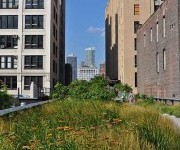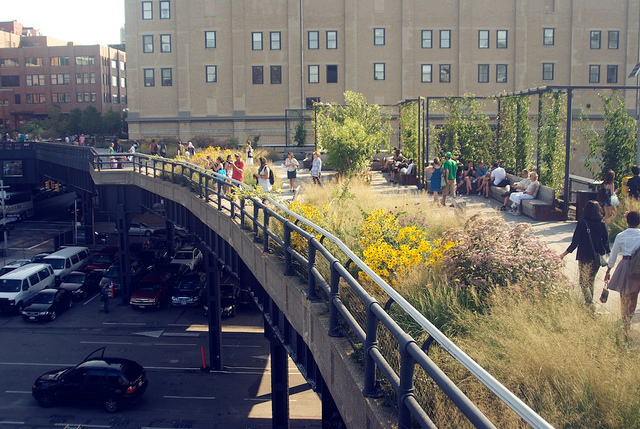What’s more ecologically valuable — national parks, or median strips and vacant lots? Could dreaded invasive species actually be more beneficial than native ones? Are environmentalists clinging to a timeless notion of nature that science has thoroughly discredited? Can we actually make nature better than it is in its “natural” state?
Emma Marris asks these and other icon-busting questions her new book Rambunctious Garden — potentially the most optimistic and controversial work about the future of nature to appear in years. Marris, a former correspondent for Nature magazine, takes big issue with enviro doom-and-gloomers and last-great-places conservationists, arguing in Rambunctious Garden that pristine wildness has been a myth for at least 13,000 years and that we live on a thoroughly domesticated planet whose nature it’s up to us to manage … and even improve upon. It sounded so heretical that I had to call her up and ask her to explain.
Q. The title of your book — Rambunctious Garden — encapsulates your vision for nature, as a garden that we as humans firmly control, consciously making decisions about which kind of nature goes where. You know that’s going to raise the hackles of a lot of environmentalists, don’t you? It has connotations of playing God and engineering nature solely for our benefit.
A. Yes. I decided to go for it and be provocative, because the title is meant to describe what the Earth is and can be. Because the planet already is a garden, and we’re kidding ourselves if we don’t admit the depth of human influence over nature. We’re in charge about where plants and animals are, either intentionally or unintentionally. It’s our space that we’re landscaping now.
Q. Like a farm?
A. It doesn’t have to be a sterile, formal garden that doesn’t have any sort of oomph or spirit to it. It can have this rambunctious and free side to it. We can let parts of the garden go feral, and it can have a lot of energy and beauty to it, but it’s still ultimately a garden. We’re still ultimately in charge.
The flip side of that phrase also describes the future home garden. I’m sitting at my desk right now, looking across the street at my neighbor here in Columbia, Mo., and her front yard is a very short, neat, tidy lawn and about half‑a‑dozen hybrid, sterile, ornamental flowers in a row. If you replace that with something much more biodiverse, much more untended, weedy-looking, buggy, your biodiversity is going to go way up. Your conservation value can go way up, and you get a more rambunctious kind of garden aesthetic. So I meant for the phrase to work on both scales — the whole planet, and your backyard.
Q. That’s a big theme for the book — that nature is everywhere, and why don’t we embrace that? That nature isn’t just some spectacular landscape, the way most conservation organizations talk about it, but that it’s your backyard, the sliver of median strip you drive by every day, and in vacant lots and industrial waterways, and that’s the sense of nature that we should be cultivating, as background to our everyday lives. But doesn’t that argument really reemphasize the marginality of nature, a nature that’s weedy and degraded and that no one will really fight for?
A. When you use the phrase “marginal” to describe this kind of nature, that’s a tip-off as to where you’re coming from. Because nature isn’t marginal. Dirt is underneath everything — the built landscape floats like islands on the sea of nature. Some of that nature pokes through in skinny bits, but when you connect those together, there’s a lot of nature.
And just because I want people to get out and get excited about the vines growing in the alley doesn’t mean that we shouldn’t also get excited about going to national parks, or that conservation should swerve away from having big interconnected pieces of undeveloped nature for some species. What I’m really proposing is a shift in our value system. What we value and don’t value can change. “Weedy” is an interesting cultural concept — in reality, weeds are successful plants. We should celebrate them, because they’re the plants we don’t have to worry about it. They’re gong to be fine. They’re the resilient part of nature.
But you’re right — we do have a long road to go before we look at an empty lot and, instead of thinking “neglected,” “weedy,” “trash,” we instead think: “Oh, I wonder what species are here. Gosh, there must be lots of pollination going on in this area, and, boy, if I come here at a certain time of day, maybe I can see some neat bird species. And, oh, gosh, isn’t this pretty?” But the weeds are the nature we’re beating back constantly.
Q. Is there enough of that kind of nature around to make a difference, both for biodiversity and for what nature gives us?
A. My argument comes down to acreage. Big national parks have an impressive amount of acreage, but if you look at doing conservation in all these little spaces, the combined acreage of those could kick the ass of the acreage of the big parks. It’s just a huge playing field that we can do conservation on. It’s practically everything. Getting a certain amount of conservation value out of farm management, for instance — that would be a huge victory globally.
Q. You write a lot about conservation in Europe versus how it’s practiced in America. Is Europe ahead of America in understanding this?
Emma Marris.
A. Yeah, absolutely, and not necessarily because they’re massively enlightened. It’s because they don’t have the Grand Canyon to distract them. They don’t have the grand wildernesses to take over their mental space, so they’ve been able to see the beauty and complexity of nature in these much smaller canvases. And they’re constantly fiddling with their conservation efforts. Management of nature is just second nature to them. They have to work really hard not to manage things, whereas we have to sort of grit our teeth to admit to ourselves that we do have to manage things.
Q. You have this fascinating chapter on the Oostvaardersplassen, a nature reserve outside of Amsterdam in which an entire landscape has been designed by an ecologist to run as it did 10,000 years ago, except the predators are largely gone, so it’s been created for nothing to look as if nothing had ever changed. Except, of cour
se, that it’s one of the most intensely managed places you could possibly find outside of agriculture. How do you feel about re‑wilding projects like this? Are they valuable? Are they curiosities? What are they saying to us?
A. I love that place. I mean, here you are, in one of the tidiest, densest, most organized countries in the world, and then you go through these gates, and all of a sudden, you’re in the savannah, with huge herds of animals running around. It’s fascinating and just unbelievable.
And if part of what we value about nature is that sense of awe that it can give us, I was awed by that place. They’ve also had a lot of success attracting animals that have showed up voluntarily and responded well to the habitat. So I think that if that keeps happening, then the Oostvaardersplassen is an argument that re‑wilding projects are not just curiosities but can be really valuable conservation tools.
Q. Back to the garden idea: You’re advancing a radical idea in this book — that people can make more nature or better nature than we have now. That cuts directly against the usual pessimistic paradigm of environmentalism — as advanced by Bill McKibben and others — which assumes that there is a set amount of nature, that nature left alone is the ideal, and all we can do is defend it against the ravages of rampant development. How did you come to this idea?
A. Partly because I was never classically trained as either an ecologist or an environmentalist. So I came to the ecology and conservation beat at Nature as an outsider, and while I sort of casually held a number of the sort of common beliefs about what is wilderness and what counts as nature, I wasn’t really wedded to them culturally. So it was easier for me to see where some of the more traditional ideas of conservation and environmentalism are starting to come apart at the seams a little bit, the more we learn about paleoecology and the dynamic nature of ecosystems and how nature has always been changing. And this thinking has been popping up at ecology conferences over the last few years.
I also had a childhood where I spent a lot of time in really crappy ecosystems and had a ball — in badly maintained city parks and third-growth forests — and it just never occurred to me that I wasn’t in nature.
Q. But you’re basically saying there is no wilderness anymore — that nature as we once thought about it, a place apart from humanity, untouched by it — doesn’t exist.
A. That’s now generally acknowledged in the literature. I have to add: My personal experiences in nature have always been pretty close to the road, and when I started hanging out with ecologists, I found that they were sticking pretty close to the road, too. Then it sort of suddenly hit me: Everything is now close to the road. You have to work really hard to get away from it.
Q. Conservation doesn’t come off really well in your book — it seems dogmatic, nostalgic, sometimes even anti-scientific, and not ready to take up the challenge of the economic and cultural forces that seem to be arrayed against it. In your view, how can conservation catch up?
A. First, I hope I don’t come across as really beating up on conservationists, because I admire them very much, and I feel that what they’re trying to do is a really important thing.
One priority I think conservation has to focus on more is genetics. I’ve very fond of using a genetic lens — genes are the raw material of what we have to work with for the future, so it seems a smart move to throw out as few genes as possible.
But I do think that keeping conservation and environmentalism separate from other progressive movements like human rights and global human development has made environmentalism just another special interest fighting for its place, almost in competition with some of these other positive movements. That’s got to change. You can’t just care about nature and not care about humanity. So an ideal mix would be a conservation movement that was also strong on human rights and human development, with a mix of priorities that was decided on in a very fair, democratic way.
I also think that there will be change toward the directions I outline in the book — whether the conservation field wants them or not — just on the basis of generational turnover of its scientists. There’s that old chestnut about there are no revolutions in science, you just wait for the old guard to die, and I think there’s probably a bit of truth to that in this case, too.
Q. In the book, you talk about a number of bêtes noire for conservation — including assisted migration of species in the face of climate change to other geographies where they might have a chance of surviving. That’s still a really controversial topic with conservationists.
A. Conservationists should get on board with assisted migration, because the industry is going to lead the way. What is industry going to move? Timber species, crop species. They might, if they’re clever, move the wild ancestors of crop species, so that we’ll still have good pools of them to play with, and they might move horticultural species. But who is going to move everything else? Who is going to move the little squiggly guys that aren’t as glamorous or aren’t commercially valuable? If conservationists find the whole thing too distasteful because it’s meddling with nature, then they might as well stand back and watch those squiggly guys turn to charcoal.
Q. Final question: What’s your favorite place on Earth, and does it match up with the kind of nature that in Rambunctious Garden you’re asking people to revalue?
A. I grew up in Seattle, and I really like the forests in the Pacific Northwest. They don’t have to be old growth. What I really love is the bounce of the turf in a forest with lots of cedar and Douglas fir, because of all the needles that have accumulated in the turf.
Q. So not necessarily a managed place?
A. No, although I’m also thinking about a place I haven’t been to in years in the Cascade Mountains, which a childhood friend’s parents owned, which had third-growth forest with mostly alders and salmonberries and other early successional stuff, and then some big, old stumps from when it had been logged. I spent many happy summers there just really enjoying the space. It never really occurred to me that the nature there wasn’t good enough.





